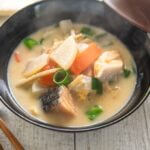
My Sake Lees Soup with Salmon (Salmon Kasujiru) is a kind of miso soup mixed with sake lees. The soup contains plenty of vegetables and salmon fillet. Sake Lees Soup (Kasujiru)is usually eaten in winter as it warms you up from the core of your body on a cold day. Watch the video.
If you are a vegetarian, use vegetarian dashi stock and replace fish fillets with tofu or other ingredients.
Don't forget to see the section 'MEAL IDEAS' below the recipe card! It gives you a list of dishes that I have already posted and this recipe that can make up a complete meal. I hope it is of help to you.
- 200g/7oz salted salmon (skin on, note 1)
- 100g/3.5oz daikon
- 30g/1.1oz burdock (note 2)
- 50g/1.8oz carrot
- ½ block konnyaku (about 125g/4.40z)
- 1 aburaage
- 2 stems green onion (about 30g/1.1oz)
- 700ml/1.5pt dashi stock
- 100g/3.5oz sake kasu (sake lees)
- 45g/1.6oz miso (note 3)
-
Salmon: Cut the salmon into bite-size pieces, then pour boiling water over them in a sieve. This removes the fishy smell.
-
Daikon: Halve or quarter the daikon vertically depending on the diameter of the daikon root. Then slice them into about 5mm/3⁄16" thick semi-circle or quarter-circle pieces.
-
Carrot: Cut into rectangle slices of approximately 4cm x 1cm x 3mm/1½" x ⅜" x ⅛".
-
Burdock: If using fresh burdock root, cut it into thin matchsticks of about 4cm/1½" long. As soon as you cut them, put them in water to prevent discolouration. Frozen burdock is already cut into matchsticks.
-
Konnyaku: Cut it into rectangle slices of approximately 4cm x 1cm x 3mm/1½" x ⅜" x ⅛" (note 4).
-
Aburaage: Halve it lengthwise, then slice into 5mm/3⁄16" wide strips.
-
Green onion: Cut it into 1cm/⅜" long pieces.
-
Put about 150ml/5.1floz of dashi stock and sake kasu in a blender and whiz until the sake kasu becomes a smooth paste (note 5).
-
Add miso and whiz to blend them well.
-
Put remaining dashi stock, daikon, carrot, burdock, and konnyaku pieces in a pot and bring it to a boil.
-
Reduce heat to medium and cook with a lid on for about 5 minutes until the root vegetables are almost cooked through.
-
Add salmon and aburaage to the pot and cook for a few minutes. Ensure that salmon is cooked through.
-
Add the Sake Kasu Mixture to the pot, gently mixing into the broth.
-
When it starts boiling again, scatter the green onions and turn the heat off.
1. If you don’t have salted salmon, you can use a fresh salmon fillet and salt it before using. If you have time, sprinkle ½ teaspoon of salt all over the fillet and leave it overnight in the fridge. When in a hurry, sprinkle 1 teaspoon of salt all over the salmon and leave for 2 hours. Rinse the salt off and pat dry with a paper towel.
It is best to keep the skin on the salmon so that the salmon pieces don’t break easily. But if you prefer, you can remove the skin.
2. I used frozen burdock, which was sold for Kimpira Gobo. They were cut into matchsticks. Frozen sasagaki cut burdock is OK too.
If you can get fresh burdock root, that’s better. Cut it into thin matchsticks and leave them in water to prevent discolouration.
3. You can use any kind of miso. I used brown miso. Depending on the colour of your miso, the soup will be slightly whiter or browner than mine.
4. A half konnyaku block is about 8cm x 7cm x 2cm/3⅛" x 2¾" x ¾". So, I sliced the block horizontally, making 2 x 1cm thick blocks. Then halve them crosswise making 4 pieces of 4cm x 7cm x 1cm/1½" x 2¾" x ⅜" pieces before slicing each piece into 3mm/⅛" thick rectangle strips.
5. You can use a mortar & pestle or a bowl & a whisk instead of a blender but it will take longer to make a smooth paste.
6. You can keep Kasujiru for a few days in the fridge.
7. Nutrition per serving.
serving: 331g calories: 186kcal fat: 8.7g (13%) saturated fat: 1.8g (9%) trans fat: 0.0g polyunsaturated fat: 2.8g monounsaturated fat: 2.9g cholesterol: 13mg (4%) sodium: 719mg (30%) potassium: 515mg (15%) carbohydrates: 9.5g (6%) dietary fibre: 3g (12%) sugar: 2.4g protein: 12g vitamin a: 45% vitamin c: 15% calcium: 5.8% iron: 5.7%